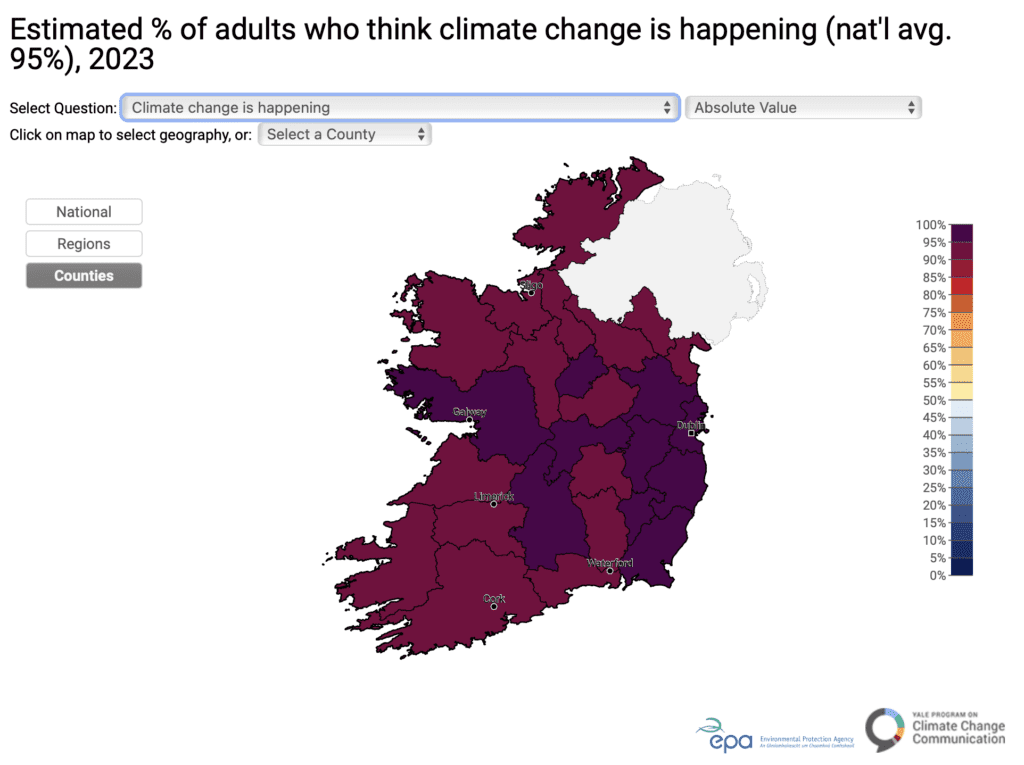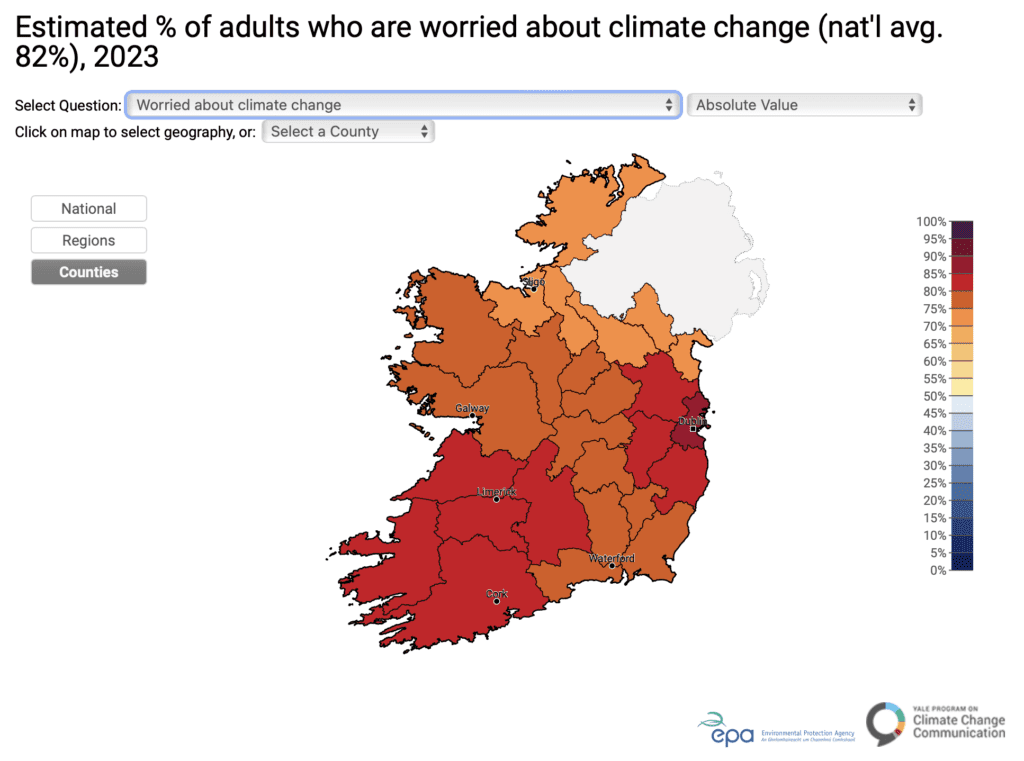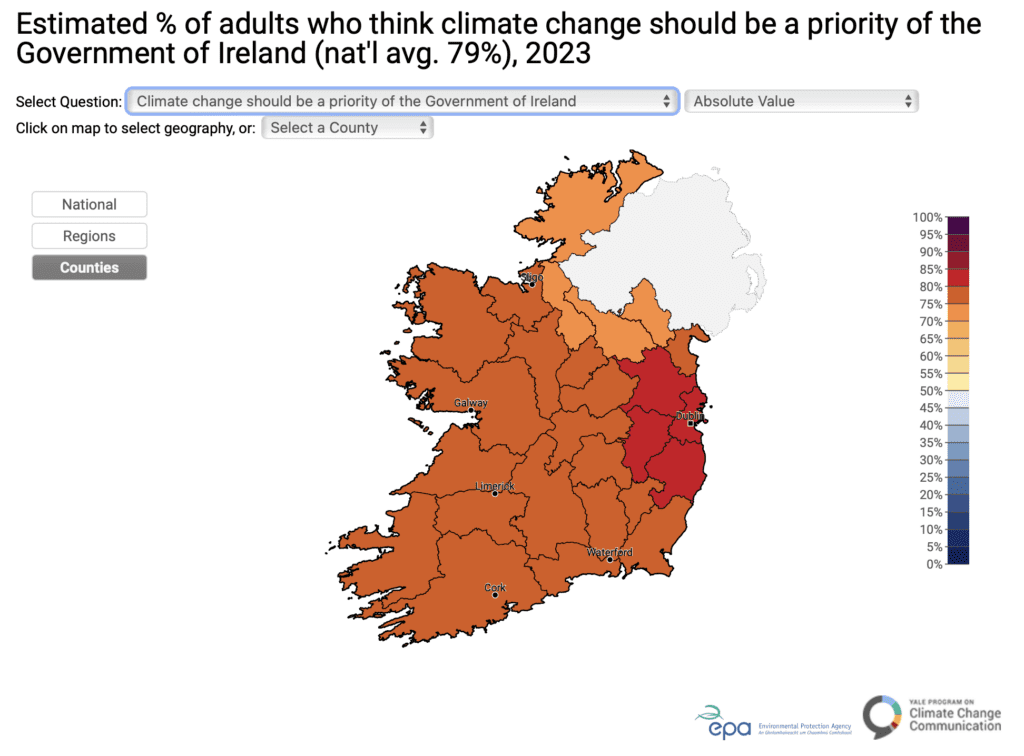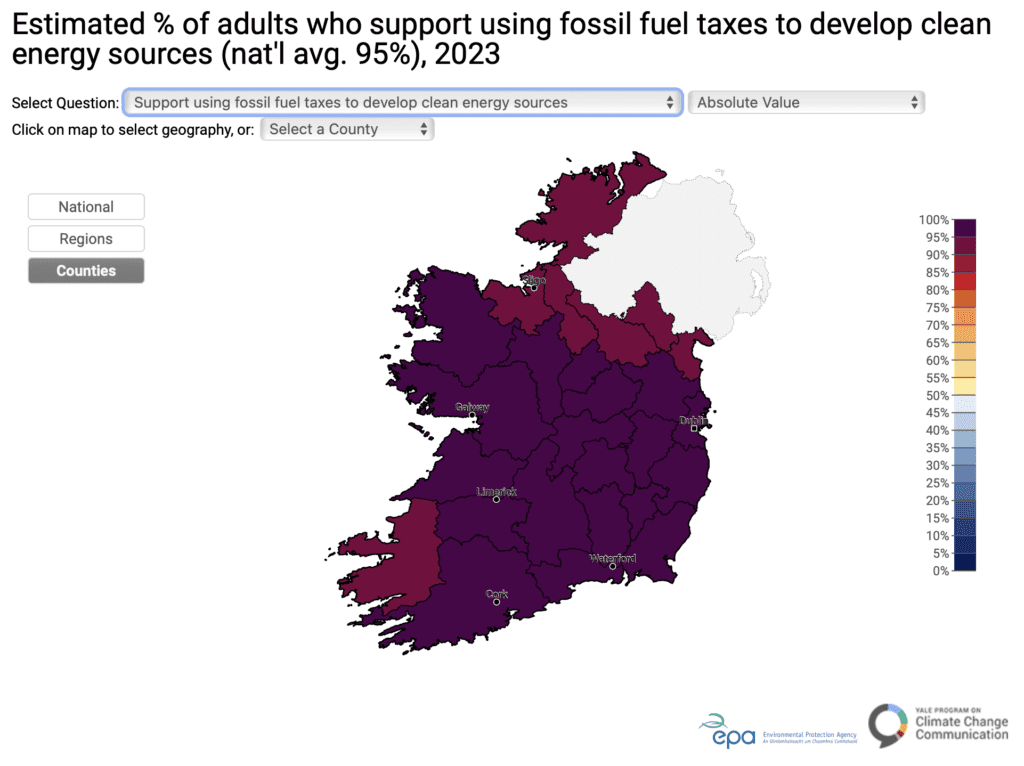Climate Note · Nov 19, 2024
Climate Change’s Four Irelands and the Irish Climate Opinion Maps, 2023
By Jennifer Marlon, Martial Jefferson, Emily Goddard, Marija Verner, Jennifer Carman, Desmond O’Mahony, Conor Quinlan, Seth Rosenthal and Anthony Leiserowitz
Filed under: Audiences and Beliefs & Attitudes
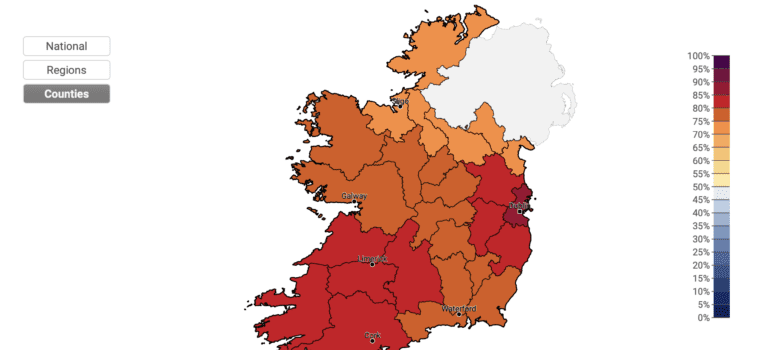
The Irish Environmental Protection Agency commissioned the Yale Program on Climate Change Communication to collaborate on a nationally representative survey of public climate change beliefs, risk perceptions, policy preferences, and behavior in Ireland. The research insights are being used to inform the National Climate Action Plan and the National Dialogue on Climate Action. Today, we announce two releases from this partnership: Climate Change’s Four Irelands, 2023 and the Ireland Climate Opinion Maps, 2023.
Across Ireland, most people are aware of the challenges posed by climate change to their own country and to people worldwide. This widespread awareness has led to strong concern about climate risks and support for climate and clean energy policies, making Ireland a role model of successful public engagement.
However, significant misperceptions still linger, even in Ireland. Many people in Ireland still don’t fully understand that climate change is human-caused and an immediate threat. Climate change remains a distant problem to many – affecting other people, in other places, at some future time – rather than a direct threat to their own lives and communities. This highlights the ongoing challenge of communicating the urgency of climate action.
Climate Change’s Four Irelands, 2023
Our analysis identified four climate change audiences in Ireland. The Alarmed (34% of the Irish population) understand that human-caused climate change is a real and immediate threat. The Concerned (48% of the Irish population) are convinced that climate change is serious, but compared to the Alarmed are less worried and view it as a less immediate threat. The Concerned also have lower levels of support for climate change policies. For instance, only 35% of the Concerned think climate change should be a very high priority for the Government of Ireland compared to 66% of Alarmed. The Cautious (14% of the Irish population) think climate change is happening but are less sure of the causes and are less likely to think it will affect them personally. The Doubtful (4% of the Irish population) are not worried about climate change and do not perceive it as a threat.
The differences between the Alarmed and Concerned are important. The belief of the Concerned that climate risks are still distant in time and space may constrain more ambitious national climate action. Scientific projections of climate impacts indicate that human-caused climate change will affect everyone a great deal, not just “a moderate amount.” Even the wealthiest individuals will not avoid the cascading effects that increasing heat, flooding, and drought will have on food, energy, transportation, and other critical systems. Even in Ireland, which has thus far been relatively protected from the most extreme heat waves and wildfires, flooding, sea level rise, and coastal erosion will increasingly undermine not only homes and infrastructure but livelihoods and economies, which are heavily dependent on coastal industries like tourism and fishing. This finding is consistent with what we have found around the world – that even in places with high levels of belief that climate change is happening, many people do not yet perceive that it will affect them personally and that preventative action is urgently needed.
To safeguard Ireland’s – and the rest of the world’s – future, it is critical to help the public bridge the gap between perception and reality, supporting a sense of urgency matching the speed and scale of the climate challenge. Lessons from communication science can help. Consensus messaging – emphasizing that 97% of scientists agree that human-caused climate change is happening – for instance, builds public trust and acceptance. Communicating descriptive social norms encourages people to act when they see others engaging in pro-environmental behaviors. Focusing on positive solutions and framing messages with hope and efficacy in addition to clearly communicating the risks can inspire action by showing that many solutions are within reach. By connecting climate change to shared values like health and energy security, communicators can make climate change more salient and motivate lasting engagement.
Irish Climate Opinion Maps
As part of our project with the Irish EPA, we developed models, maps, and an online, interactive tool depicting public responses to climate change at the national, regional, and county levels. The vast majority of adults in Ireland think climate change is happening (95%). The map below exhibits very little spatial variation across different counties. This measure ranges from 93% in Cavan, Clare, and Monaghan counties, to 96% in Dublin, Galway, and Wexford counties.
However, only about half of adults in Ireland think climate change is mostly caused by human activities (55%). This ranges from 47% in Donegal and Sligo counties to 59% in County Dublin, the home of the country’s capital, and there are 6 counties where only a minority understands that climate change is mostly human-caused. The counties where the belief in human-caused climate change is the lowest are mostly in the northern border region, with the exception of County Laois, which is located in central Ireland.
More than three-fourths of adults in Ireland are worried about climate change (82%). People in counties clustered in the north of the country – Cavan, Donegal, Leitrim, Monaghan, and Sligo – are the least worried about climate change (all at 74%), and people in County Dublin are the most worried (85%).
Next, nearly two-thirds of adults in Ireland are worried about flooding harming their local area (62%), including majorities in all counties. Worry about flooding is lowest in the landlocked County Cavan (56%) and highest in the coastal County Cork (73%), which borders the Celtic Sea to the south and the Atlantic Ocean to the west. Counties that face the open ocean are more worried about flooding than counties that are either landlocked or located in the East next to the Irish Sea.
A large majority of adults in Ireland think climate change should be a priority of the Government of Ireland (79%). The support is high in all counties but is lowest in Cavan, Donegal, Leitrim, Louth, and Monaghan counties (75%) and highest in Dublin and Wicklow counties (82%). Support is lowest in the north and highest in the east but overall, people across Ireland say that climate change should be a government priority.
Finally, nearly all adults in Ireland support using fossil fuel taxes to develop clean energy sources (95%). Similar to the acknowledgment of climate change happening, the support for this policy is nearly universal across Ireland with very little variation.
Explore the maps further by clicking on a specific county or region and compare the results across questions and with other geographic areas. Beneath each map are bar charts displaying the results for every question at whichever geographic scale is currently selected. See the Methodology tab for more information about uncertainty estimates. Also, see the Survey Question Wording tab to see how responses were compiled.
Methods
Climate Change’s Four Irelands
The segmentation analysis is based on two waves of the Climate Change in the Irish Mind study (CCIM), a nationally representative survey of adults 18 years and older, collected from May through July of 2021 (n=4,000) and from August through October of 2023 (n=1,330). The model was developed using CCIM Wave 1, where we applied latent class analysis (LCA) on a subset of survey questions to identify distinct audience segments based on response patterns concerning climate change. LCA clusters individuals into smaller audiences or “classes” based on these patterns. In this report, we applied the segmentation model developed from Wave 1 to classify participants in the Wave 2 dataset. This approach has been successfully used in other large-scale surveys. The audience proportions in Wave 2 did not differ statistically from Wave 1, and all results presented here are based on the Wave 2 dataset.
The Irish Climate Opinion Maps
The maps are also based on two CCIM survey waves. All survey respondents were geolocated at the region, province, and county level. All dependent variables included in the opinion maps were re-coded as binary (0/1). Two participants were removed due to missing data, so our total combined sample size was n=5,328. We applied a multi-level regression model with post-stratification (MRP) using individual-level demographics and geographic characteristics. Gender, age group, an interaction term of gender by age group, year, and geographic grouping by region, province, and county are treated as random effects. For post-stratification, we use data from the Irish Census cross-tabulated by age group and gender across all provinces, regions, and counties for 2016. Our fitted model was then used to estimate the average opinion of each demographic-geographic individual type for each year. For instance, the model estimated the average response of a male between the ages of 18 and 44 living in Dublin in 2016.
The multilevel regression model with post-stratification (MRP) method has been previously validated by multiple public opinion scholars. We validated our specific model through comparison with aggregated results from the weighted survey data in the counties with the most survey respondents (i.e., Cork, n=532; Dublin, n=1,700; Kildare, n=273; Galway, n=264; Wicklow, n=206; Donegal, n=210). The average Mean Absolute Error (MAE), or the average absolute difference between the model estimates and the survey averages is 2.734 percentage points.
Additional information about the survey data underlying the maps is available in the 2023 CCIM report as well as the 2023 Climate Change’s Four Irelands report.
